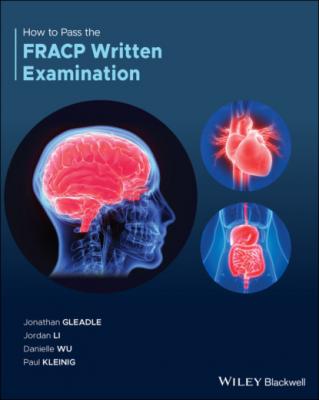How to Pass the FRACP Written Examination. Jonathan Gleadle
Читать онлайн.| Название | How to Pass the FRACP Written Examination |
|---|---|
| Автор произведения | Jonathan Gleadle |
| Жанр | Медицина |
| Серия | |
| Издательство | Медицина |
| Год выпуска | 0 |
| isbn | 9781119599548 |
Takotsubo cardiomyopathy was once thought a benign disease with transient systolic and diastolic left ventricular dysfunction with a variety of wall‐motion abnormalities. However, rates of in‐hospital shock and death were similar in patients with Takotsubo cardiomyopathy and ACS. Other complications such as ventricular tachycardia, ventricular aneurysm, and ventricular rupture have been reported. The rate of major adverse cardiac and cerebrovascular events is 10% per patient‐year, and the rate of death is 5.6% per patient‐year, during long‐term follow‐up.
Angiotensin‐converting enzyme (ACE) inhibitors or angiotensin‐receptor blockers have been shown to improve survival at one year. Beta‐blockers showed no survival benefits at one year following diagnosis of Takotsubo cardiomyopathy.
Templin C, Ghadri J, Diekmann J, et al Clinical Features and Outcomes of Takotsubo (Stress) Cardiomyopathy. New England Journal of Medicine. 2015;373(10):929–938.
https://www.ncbi.nlm.nih.gov/pubmed/26332547
32. Answer: B
TAVI valves are bioprosthetic, so the recommendation is for dual antiplatelet therapy with aspirin and clopidogrel for 3–6 months, with aspirin continued lifelong.
Severe aortic stenosis (AS) is the most common form of valvular heart disease in the developed world, affecting 7% of adults older than 65 years. Most patients with early AS are asymptomatic. Currently, there is no evidence to support surgical aortic valve replacement (SAVR) or TAVI in asymptomatic patients, even with severe AS. However, once symptoms of angina, syncope, or heart failure develop, there is significantly increased mortality if untreated. SAVR remains the preferred treatment for low risk patients. For intermediate and high‐ risk patients, TAVI in suitable candidates is at least non‐inferior.
According to the largest trial comparing TAVI to SAVR, major complications include:
Major vascular complication rate (7.9% TAVI vs 5% SAVR).
Major stroke rate (3.2% TAVI vs 4.3% SAVR).
Heart block (secondary to direct compression of the bioprosthetic valve on the conduction tissue) requiring pacemaker insertion (8.5% TAVI vs 6.9% SAVR).
Acute kidney injury (1.3% TAVI vs 3% SAVR).
Other: Paravalvular aortic regurgitation (<5%), infectiveInfective endocarditis, catastrophic complications: coronary obstruction, aortic dissection, cardiac perforation (0.2–1.1%).
Adams H, Ashokkumar S, Newcomb A, et al. Contemporary review of severe aortic stenosis. Internal Medicine Journal. 2019;49(3):297–305.
https://onlinelibrary.wiley.com/doi/abs/10.1111/imj.14071
33. Answer: A
This patient has an inferolateral STEMI due to multivessel coronary disease. CABG is indicated in patients with severe left main coronary artery disease or triple vessel disease. CABG offers improved survival and quality of life for patients with more extensive coronary disease with reduced left ventricular systolic dysfunction and remodelling. Furthermore, patients with diabetes and multivessel disease have been shown to benefit from CABG.
Percutaneous coronary intervention (PCI) may be considered for patients with multivessel coronary artery disease who are not a candidate for open heart surgery due to comorbidities and poor functional status. PCI even with biventricular pacemaker–defibrillator is not the best option for this patient. He is young; stage 3A CKD and treatment with adalimumab are not contraindications for CABG.
Infarct‐related artery (IRA) or culprit‐only revascularisation in primary PCI is associated with higher rate of long‐term major adverse cardiac events (MACE) compared with multivessel treatment. Patients scheduled for staged revascularisation experienced a similar rate of MACE to patients undergoing complete simultaneous treatment of non‐IRA.
Pineda AM, Carvalho N, Gowani SA, Desouza KA, Santana O, Mihos CG, Stone GW, Beohar N. Managing Multivessel Coronary Artery Disease in Patients With ST‐Elevation Myocardial Infarction: A Comprehensive Review. Cardiol Rev. 2017 Jul/Aug;25(4):179–188.
https://pubmed.ncbi.nlm.nih.gov/27124268/
34. Answer: D
Troponin is a protein complex of three subunits (T, I, and C) that are involved in the contractile process of skeletal and cardiac muscle. Both cardiac and skeletal muscle express troponin C; whereas troponin T and I are cardiac‐specific. Cardiac troponin (cTn) is integral to the diagnosis of acute coronary syndrome (ACS), but is elevated in many patients without ACS.
Conditions associated with non‐ACS cTn elevations include:
Tachyarrhythmias
Congestive heart failure
Malignant hypertension
Sepsis
Myocarditis
Valvular heart disease (aortic stenosis)
Aortic dissection
Pulmonary embolism, pulmonary hypertension
Chronic kidney disease
Acute ischaemic or haemorrhagic stroke
Cardiac contusion or cardiac procedures (CABG, PCI, ablation, pacing, cardioversion, or endomyocardial biopsy)
Infiltrative diseases (amyloidosis, hemochromatosis, sarcoidosis)
Myocardial drug toxicity or poisoning (doxorubicin, trastuzumab, snake venoms)
Rhabdomyolysis.
As cTn can be detected among healthy adults, there are guidelines regarding what is considered an ‘elevated’ level. The joint European/American College of Cardiology guidelines define a clinically relevant increase in cTn levels as a level that exceeds the 99th percentile of a normal reference population. However, using a statistical cut‐off means that some normal individuals will have a value above this cut‐off, and because other clinical causes can cause an elevation, cTn should be interpreted in the context of pre‐test probability of ACS. cTn concentrations are elevated in one in eight patients in the emergency department (ED).
High‐sensitivity assays can accurately detect cTn at lower levels than older‐generation assays, giving them higher sensitivity for the detection of ACS at presentation, which means that the time interval to the second measurement of high‐sensitivity cTn (hs‐cTn) can be significantly shortened, thereby reducing the time to diagnosis and improving efficiency in the ED. There is concern that hs‐cTn may have lower diagnostic accuracy in patients with low pre‐test probability for ACS. Concern of misinterpretation of these hs‐cTn elevations as ACS and patient harm associated with potential unnecessary therapies such as anticoagulation and coronary angiography has led some experts to recommend withholding hs‐cTn testing in patients with a low pre‐test probability for ACS.
However, practice guidelines also highlight that ACS frequently presents with atypical symptoms especially in the elderly and patients with diabetes. It recommends scrutiny for ACS with ECG and hs‐cTn. These
